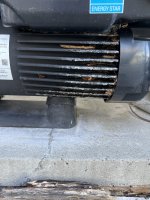I didn't think about that. Let me confirm my understanding. Salt water is denser than freshwater, so when I exchange, I should put my submersible pump in the deepest part of the pool and put the fill hose on the top step on the shallow end?
Sorry missed this, i'm sure everyone in same boat with heavy cleanup not much computer time. that's what i did and no science expert but
that whole link on no drain replacement didn't quite make sense to me, but salt vs fresh does but i think the 2 say essentially same thing.
so i would do a vac to waste first if you have a working pump and don't mind the high salinity thru the pump. then do replacement.
I ended up doing
1) sump in deep end, fill from shallow at least 70% in my case but i'm higher than ground level. I actually drained a good 60% first, then started my 50% replacement from there. That may not be comfortable for you depending on your shell and surrounding water level or table. Alot of florida pools are elevated on stem walls so ground water not so much in play depending on height above waterfront.
2) once salinity was down i closed everything except skimmer and vacuumed (old school pole and head) to waste to not make my existing de so nasty. Though i suppose if above holds true that the high saline is on the bottom you're still pumping high saline thru the pump so the point may be moot and skip this intermediary step trying to avoid the ^ salt water?
3) at that point bottom was pretty clean, so then i did another replacement, aiming for 10-15% more time it took to drain first half.
4) at that point pretty dang clear just bit cloudly (more so in my case as i tried a useless robot and it can't filter silt). So then just get the de cleaning things up or whatever.
I feel comfortable to swim in that scenario, once shocked, and filterered through the de filter.
Anyways all the more reason to prepare a portable filter for these cases, having an old pump makes it so much less to think about. Though this thing man....whatever i put high wasn't high enough so they get you
eventually anyways.









